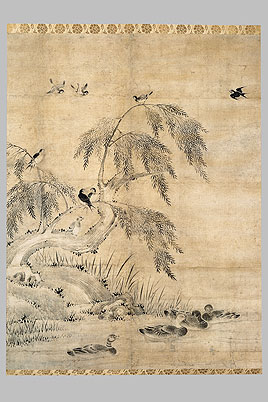
Decorative Objects
 |
Kano school, possibly by Kano Shõei (Japanese, 1519-1592) Birds, Ducks, and Willow Tree Japan Muromachi period (1392-1573), mid-16th century Folding screen panels mounted as a hanging scroll; ink on paper Image only, H. 54 x W. 45 in. (137.2 x 114.3 cm) Asia Society, New York: Mr. and Mrs. John D. Rockefeller 3rd Collection, 1979.213 |
The dimensions of this painting, now mounted as a hanging scroll, and the seam running down its center are clues to its previous context. The work originally decorated two panels of a folding screen, which, like many other screens produced in sixteenth-century Japan, was probably composed of six panels. In its original form, the screen may have been used to decorate or divide a room.
In these two panels, a thin layer of diluted ink wash was applied across the background to create a misty atmosphere. Swallows, sparrows, and ducks in flight, perching on the tree, or waddling in water form a lively scene in the landscape. The long, fine ink brushwork employed on the rocks and on the willow tree trunk is a characteristic feature of the Kano school of painting in the sixteenth century. With support from the shogunate as well as other wealthy patrons, the Kano school operated under a studio system, in which most of the works were produced by masters together with their disciples.